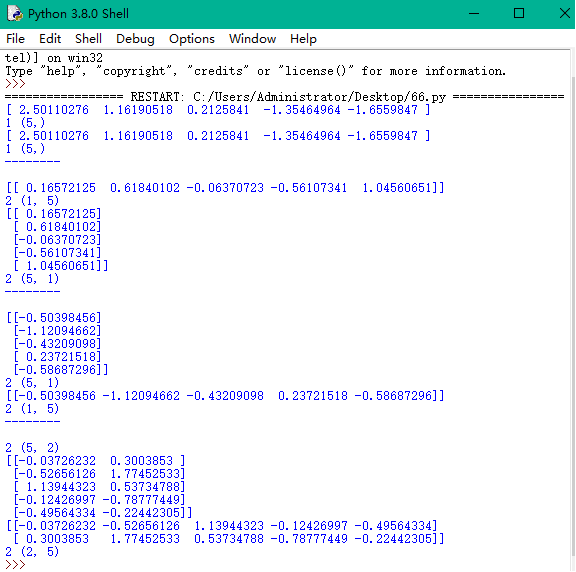1 import numpy as np 2 3 ''' 4 数组:一维,秩为1 5 利用Numpy中random模块中的randn函数生成的一维数组, 6 既不是行向量,也不是列向量,而是秩为1的数组, 7 特点: 8 只有一个'[]' 9 是数组,不是向量或矩阵 10 ''' 11 a = np.random.randn(5) 12 print(a) 13 #[ 2.50110276 1.16190518 0.2125841 -1.35464964 -1.6559847 ] 14 print(a.ndim, a.shape) 15 # 1, (5,) 16 print(a.T) 17 #[ 2.50110276 1.16190518 0.2125841 -1.35464964 -1.6559847 ] 18 print((a.T).ndim, (a.T).shape) 19 # 1, (5,) 20 print("-------- ") 21 22 23 24 ''' 25 向量和矩阵都是为二维数组 26 ''' 27 28 ''' 29 行向量: 30 特点:两个方括号'[]' 31 ''' 32 b = np.random.randn(1,5) #1行5列的行向量 33 print(b) 34 #[[ 0.16572125 0.61840102 -0.06370723 -0.56107341 1.04560651]] 35 print(b.ndim, b.shape) 36 # 2, (1, 5) 37 print(b.T) 38 ''' 39 [[ 0.16572125] 40 [ 0.61840102] 41 [-0.06370723] 42 [-0.56107341] 43 [ 1.04560651]] 44 ''' 45 print((b.T).ndim, (b.T).shape) 46 # 2, (5,1) 47 print("-------- ") 48 49 50 ''' 51 列向量 52 ''' 53 e = np.random.randn(5,1) #5行1列的列向量 54 print(e) 55 ''' 56 [[-0.50398456] 57 [-1.12094662] 58 [-0.43209098] 59 [ 0.23721518] 60 [-0.58687296]] 61 ''' 62 print(e.ndim, e.shape) 63 #2, (5,1) 64 print(e.T) 65 #[[-0.50398456 -1.12094662 -0.43209098 0.23721518 -0.58687296]] 66 print((e.T).ndim, (e.T).shape) 67 #2 (1, 5) 68 print("-------- ") 69 70 71 ''' 72 矩阵: 73 既有行向量也有列向量,两个方括号'[]' 74 ''' 75 c = np.random.randn(5,2) 76 print(c.ndim, c.shape) 77 #2 (5, 2) 78 print(c) 79 ''' 80 [[-0.03726232 0.3003853 ] 81 [-0.52656126 1.77452533] 82 [ 1.13944323 0.53734788] 83 [-0.12426997 -0.78777449] 84 [-0.49564334 -0.22442305]] 85 86 1. 最外层的方括号表示矩阵 87 2. 内层的方括号是每行有一对:内层有5对方括号,表示5行 88 3. 内层每对方括号内有2个元素,表示2列 89 ''' 90 print(c.T) 91 ''' 92 [[-0.03726232 -0.52656126 1.13944323 -0.12426997 -0.49564334] 93 [ 0.3003853 1.77452533 0.53734788 -0.78777449 -0.22442305]] 94 ''' 95 print((c.T).ndim, (c.T).shape) 96 #2 (2, 5) 97 98 ''' 99 数组、向量、矩阵的区别: 100 可以以方括号的形式判断数组是否能够代表一个向量或者矩阵, 101 又或者通过转置看前后是否变化来判断。 102 '''
